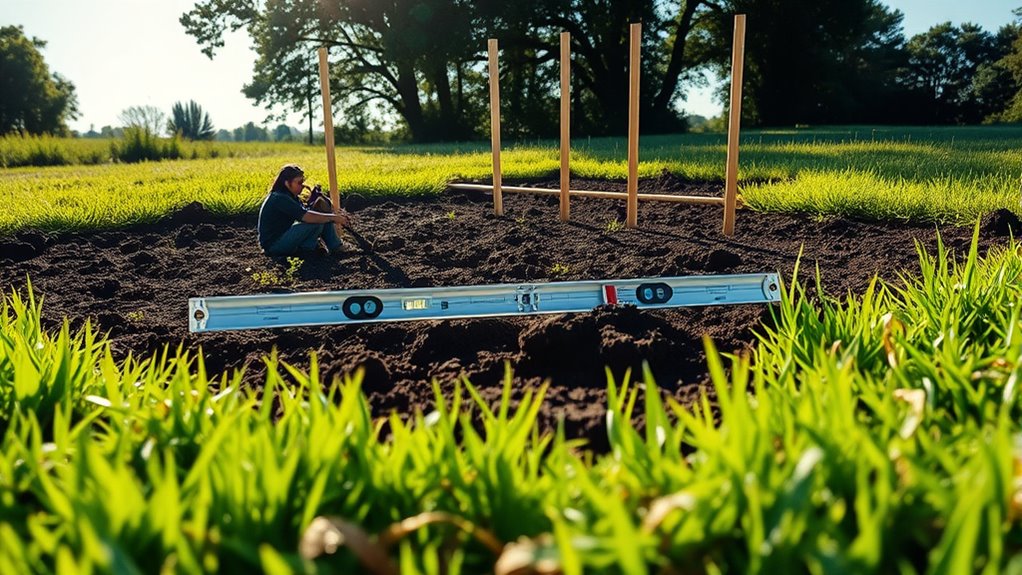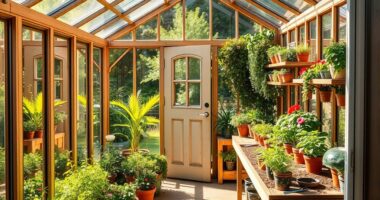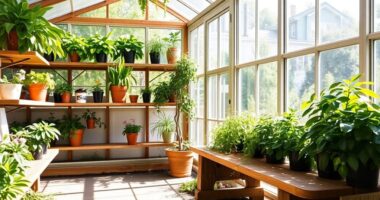To level the ground for your greenhouse base, start by clearing the area of grass and debris. Use rakes to level the ground and fill in any low spots. Mark the perimeter with stakes and string for guidance. Check for natural drainage and adjust if necessary, ensuring water flows away from the site. Compact the soil to stabilize it. By following these steps, you’ll set up a solid foundation for your greenhouse, leading to even better results.
Key Takeaways
- Clear the area of grass, weeds, rocks, and debris to prepare for leveling.
- Use rakes to level the ground, filling low spots as needed for an even surface.
- Mark the greenhouse perimeter with stakes and string for accurate layout guidance.
- Compact the soil using a tamper or vibrating plate to ensure stability before building.
- Assess and adjust for natural drainage patterns to direct water away from the greenhouse.
Assessing the Terrain

When evaluating the terrain for your greenhouse, it’s vital to contemplate how the land’s topography, shading factors, and water management will affect your setup.
Slopes can greatly influence drainage and sunlight exposure; ideally, you want a slope of up to 5% for proper drainage. If you have steep slopes, consider terracing to prevent erosion.
Proper drainage is crucial; aim for slopes up to 5%, and consider terracing on steep inclines to avoid erosion.
Nearby trees or structures can cast shadows, so make sure your greenhouse is at least 2.5 times the height of any shading object. While some shading can help during hot months, too much can hinder growth in winter.
Finally, effective water management is fundamental; use slopes to direct runoff away from your greenhouse and consider rainwater harvesting systems for sustainability.
Preparing the Ground

Get ready to transform your chosen site into a solid foundation for your greenhouse. Start by clearing the area of grass, weeds, rocks, and debris.
Next, level the ground using rakes, filling in low spots with soil or gravel. Mark the greenhouse perimeter with stakes and string to guide your layout.
Check for good natural drainage to prevent water accumulation; if necessary, consider a gravel layer for enhanced drainage. Compact the soil with a tamper or vibrating plate for stability.
Finally, make sure the ground slopes slightly to direct water away from the greenhouse. By following these steps, you’ll create a sturdy and well-prepared base for your greenhouse structure.
Building a Foundation

When building a foundation for your greenhouse, you’ll need to choose the right type and materials to guarantee stability and durability.
Consider options like concrete, wood, or gravel, each with its unique benefits and drawbacks.
Selecting the right foundation won’t only support your greenhouse but also adapt to your local climate conditions.
Foundation Types Overview
Choosing the right foundation for your greenhouse is essential, as it directly impacts stability and longevity. Here’s an overview of common foundation types to take into account:
| Foundation Type | Key Features | Best For |
|---|---|---|
| Independent Foundation | Separate blocks for load distribution | Small to medium greenhouses |
| Strip Foundation | Continuous along walls for stability | Large multi-span greenhouses |
| Pile Foundation | Deep piles for poor soil conditions | Unstable or soft ground |
| Composite Foundation | Combination of foundation types for enhancement | Specific geological conditions |
| Wooden & Concrete | Lightweight vs. durable options for different sizes | Smaller vs. larger structures |
Evaluate these options based on your greenhouse size and local soil conditions for ideal results.
Material Selection Considerations
Having established the foundation types suitable for your greenhouse, it’s now time to evaluate the materials that will form the base.
You’ll want to take into account durability first; concrete and naturally resistant wood like cedar offer long-lasting options. Cost is another factor—wooden foundations are usually cheaper than concrete.
However, be cautious of pressure-treated wood, as it can leach chemicals into the soil. Aesthetically, brick or stone can enhance your greenhouse’s look but may require more maintenance.
Verify your material choice accommodates local soil conditions and drainage needs. Finally, think about long-term maintenance and sustainability, opting for materials that minimize environmental impact while supporting your greenhouse’s structural integrity.
Managing Slopes

When managing slopes for your greenhouse, you’ll need to take into account effective drainage, proper slope grading, and the construction of retaining walls.
Each of these elements plays a vital role in ensuring your greenhouse sits on a stable and level base.
Let’s explore how to tackle these challenges and create a solid foundation.
Retaining Wall Construction
To effectively manage slopes and create a stable base for your greenhouse, constructing a retaining wall is essential.
Start by excavating the area to the required depth, following the slope’s contour for a level wall. Choose durable materials like stone or treated wood, guaranteeing they can withstand the elements.
As you build, make certain the wall is perfectly level and securely anchored to prevent shifting or collapse. Depending on the slope’s steepness, you might need multiple walls to create flat terraces.
Always consider the weight and size of your greenhouse during the design phase to maintain structural integrity.
With proper planning and construction, your retaining wall will provide a solid foundation for your greenhouse.
Effective Drainage Solutions
After constructing a sturdy retaining wall, addressing drainage is the next step in ensuring your greenhouse’s stability and plant health.
Effective drainage prevents overwatering and soil erosion, which can harm your plants. Here are three solutions to evaluate:
- Trench Drains: These are efficient but may be costly; they drain excess water through grates into pipes.
- French Drains: Using perforated pipes surrounded by gravel, they effectively remove water while being less expensive.
- Slot Drain Systems: Durable stainless steel designs provide high flow rates and are easier to maintain.
Slope Grading Techniques
As you tackle slope grading for your greenhouse base, understanding the nuances of managing different slopes is crucial.
Start by measuring the slope; divide the rise by the run to find the percentage. Aim for a gentle slope of 1 foot in rise per 50 feet of run for ideal drainage and stability.
If you’re dealing with steep slopes, consider constructing retaining walls to support the soil and create a level platform. Use leveling tools like laser levels to guarantee accuracy.
Remember, the slope’s orientation can help maximize sunlight exposure.
Finally, regularly inspect and maintain your foundation to prevent erosion and instability, securing a solid base for your greenhouse.
Ensuring Stability

When you’re setting up a greenhouse, guaranteeing stability is essential for its longevity and performance.
Start by choosing the right foundation type and considering your climate. Here are three key points to focus on:
- Foundation Types: Opt for a concrete slab for larger greenhouses, as it offers durability.
- Soil Considerations: Stabilize sandy soil and guarantee good drainage in clay soil to prevent shifting.
- Anchoring Methods: Secure your greenhouse with heavy-duty screws or anchors, especially in windy areas.
Finalizing the Base

Finalizing the base of your greenhouse is essential for guaranteeing stability and longevity. Start by selecting suitable materials; pressure-treated wood or composite work well for simple bases, while concrete blocks or gravel offer more durability. If using concrete, consider adding rebar for extra strength.
Next, utilize an 18″ bubble level or laser level to accurately check the ground, adjusting any high spots and filling low areas with soil or gravel.
Secure the frame by aligning it with the base edges, drilling pilot holes if necessary, and anchoring it with screws. For slopes, compact the soil or build a retaining wall as needed.
Finally, verify everything is square, level, and tightly secured for a solid foundation.
Checking for Drainage

To guarantee your greenhouse thrives, checking for proper drainage is essential. Poor drainage can lead to serious issues like water accumulation, harming both your structure and plants.
Ensuring proper drainage is crucial for your greenhouse’s health, preventing water accumulation that can damage both structure and plants.
Here’s what you need to focus on:
- Site Selection: Choose a location that’s elevated and receives at least six hours of sunlight daily to avoid flooding.
- Ground Preparation: Clear away grass, weeds, and debris, and make certain the ground is level. Use gravel or sand layers to enhance drainage.
- Natural Drainage Patterns: Identify and follow natural drainage patterns, grading the surrounding area to direct water away from the greenhouse.
Implementing these steps will help maintain a healthy environment for your plants and assure the longevity of your greenhouse.
Conducting a Final Inspection

A thorough final inspection is essential to confirm your greenhouse is ready for use and free from potential issues.
Start by checking the foundation for cracks, spalling, and loose mortar joints. Ascertain walls aren’t leaning or bulging, and clear any debris around the base.
Next, inspect exterior finishes and seal any penetrations, like gas and AC lines. Don’t forget to remove construction debris and verify that your address is visible.
Inside, examine wall finishes, ceilings, and floors for any damage. For mechanical systems, seal ducts and install GFCI outlets near water sources.
Finally, assess the landscaping; check the health of trees and make sure plants don’t trap moisture against your structure.
This thorough check will safeguard your greenhouse investment.
Frequently Asked Questions
What Tools Are Essential for Leveling the Ground?
To level the ground effectively, you’ll need several essential tools. A laser level provides precise measurements, while a spirit level helps you check angles.
A tape measure is vital for sizing your area correctly. You’ll also need a shovel for digging and adjusting soil levels, and a tamper to compact the soil, ensuring a stable surface.
These tools will make your leveling process easier and more accurate, setting you up for success.
How Long Does the Leveling Process Typically Take?
Picture a sculptor chiseling away at a block of marble; it takes time to reveal the masterpiece within.
Similarly, the leveling process usually takes a few hours to a couple of days, depending on the site’s complexity and soil type. If you’re working with tough terrain or have little experience, it might stretch longer.
Planning your time wisely and using the right tools can make all the difference in speeding things up.
Can I Level the Ground During Wet Conditions?
You can, but it’s not advisable to level the ground during wet conditions.
Wet soil tends to be unstable, making it difficult to compact properly. You risk erosion and may face equipment limitations, leading to safety concerns.
If you must work in these conditions, consider temporary drainage solutions or soil stabilizers to help manage moisture.
It’s often best to wait for drier weather to guarantee a stable and effective leveling process.
What Are Alternatives to Concrete for the Foundation?
Think of your greenhouse foundation as the roots of a sturdy tree, anchoring it to the earth.
Instead of concrete, you can explore wooden bases, paving slabs, gravel with pavers, or even metal and plastic options.
Each alternative brings its own strengths, like cost-effectiveness and drainage.
Just remember, choosing the right material is like selecting the perfect soil—essential for growth and stability in your greenhouse project.
How Do I Know if My Greenhouse Is Securely Anchored?
To know if your greenhouse is securely anchored, regularly inspect the anchors for signs of wear and guarantee they’re tight.
Check for any movement during strong winds or storms. If you notice shifting or instability, reinforce your anchors or consider using heavier options.
Keeping an eye on soil conditions is essential too; erosion can compromise your greenhouse’s stability.
Stay proactive to maintain a secure and safe environment for your plants!
Conclusion
By taking the time to properly level the ground for your greenhouse base, you’re laying the foundation for thriving plants and fruitful harvests. With every step—assessing, preparing, and finalizing—you’re crafting a sturdy haven that nurtures growth. Just as a gardener tends to each seed, you’re cultivating a space where life can flourish. So, roll up your sleeves, embrace the process, and watch your greenhouse bloom into a vibrant oasis of greenery and abundance.









